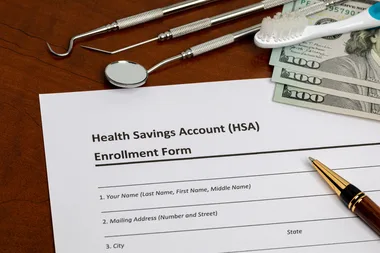Health Savings Accounts: How Do They Work?
Health savings accounts can be advantageous when your goal is to recruit new hires or improve existing employees’ job satisfaction. They are an incredible benefit that you can offer to people who work for you.
Your employees will have the opportunity to save pretax dollars and put them toward qualified medical expenses, including copays, prescriptions, dental care, contacts, eyeglasses and X-rays, as well as retirement.
Are HSA contributions tax-exempt?
Yes! HSA contributions are tax-exempt. This means you will not have to apply any payroll tax laws to any of the money that you deposit into each employee’s HSA. And because these are considered pretax contributions, they also lower how much your employees will owe in taxes on the federal level.
How can you utilize HSAs as an employer?
HSAs let you contribute — either with or without an IRS Section 125 cafeteria plan — benefits employees choose from, such as life insurance, adoption or dependent care assistance, and accident benefits. You can even offer an HSA as a separate benefit, meaning you will decide how contributions will be made.
For example, you can contribute a lump sum of money at the start of the year to your employees’ HSAs or you can spread out your contributions by breaking them down into a percentage of the grand-total contribution each pay period.
There’s also the hybrid approach. In this situation, you would deposit 40% to 50% as a lump sum and then make smaller contributions every pay period. This scenario can reduce your administrative burden while protecting you from employees who quit immediately after receiving the lump-sum contribution.
What if employees don’t need the money in their HSAs?
If employees do not need the money in their HSAs because they do not have any immediate medical expenses to pay for, they can choose to save or invest their HSA funds until they need them.
This is how HSAs differ from flexible spending accounts, which must be spent by the end of the plan year. FSA funds cannot be invested nor can they be carried over when workers are no longer employed by you.
How does offering HSAs as an employer benefit you from a tax perspective?
By offering HSAs to your employees, you can lower your total payroll taxes. Since your contributions are both tax-free and exempt from FICA taxes, you will save an additional 7.65% per tax year. Additionally, you can deduct post-tax contributions from your employees’ HSAs.
Ultimately, your contributions to your employees’ HSAs can be viewed as 401(k) matches for their health. Even though your employees will not receive a tax deduction due to your contributions to their HSAs, the extra money that you extend to them can be invested, which is another avenue for financial growth.
Why are HSAs considered tax-advantaged for employees?
HSAs are considered tax-advantaged for employees because contributions reduce their taxable income. This is true even if the money in the HSA account earns interest or investment returns over time. As long as the funds are used for qualified medical expenses, employees will not owe taxes when they withdraw money from their HSAs.
Now, HSAs coincide with an HSA-eligible health plan, and together they create a cash cushion that offsets the higher deductibles that most HSA-eligible health plans usually have. As early as the age of 65, employees will not face any penalties if they use money in their HSA for nonqualified medical expenses.
That said, they may have to pay income tax under the following circumstance: Prior to the age of 65, people who withdraw from their HSA and use the money for nonmedical expenses will face a 20% penalty as well as be responsible for any applicable taxes on said withdrawal.
Under what conditions can employees contribute to an HSA?
Even if your employees are enrolled in an HSA-eligible health plan, they might not be eligible to contribute to an HSA. One exception is if your employees are not enrolled in a health plan that is sponsored by a spouse or parent who is not part of an HSA-eligible health plan.
Contributions can also be made if your employees are not enrolled in Medicare or if those who work for you cannot be claimed as a dependent on another person’s tax return.
What are the financial advantages of HSAs?
Employees can deduct contributions from their taxes if they contribute to their HSAs with after-tax dollars during the tax year and claim a tax deduction when it’s time to file. If contributions are made through payroll deductions, your employees will also avoid paying Medicare and Social Security taxes on the money put into their HSAs.
Furthermore, HSAs allow employees to invest a portion of their funds, which can help grow their savings over time. This can be especially helpful for employees who are concerned about how they will cover their medical expenses later in life. It’s also an opportunity to build a financial emergency fund for any health-related needs that arise over time.
Unlike other financial accounts, HSAs do not have a “use it or lose it” rule. In other words, employees can carry forward any unused funds year after year, so they will not lose money that is not spent within a given year.
Additionally, you can offer FSAs alongside HSAs. For example, a limited-purpose FSA can be used to pay for dental- or vision-related expenses while the funds in an HSA can be put toward other medical expenses.
When you decide to offer HSAs as part of your company’s benefits package, you, as an employer, will lower your total health insurance premium expenses. This is because the premiums for HSA-eligible high-deductible health plans tend to be less costly than premiums for other health plans.
From there, you can use the funds you save on premiums to contribute to your employees’ HSAs.
Pam Morton
Benefits by Design Insurance Services
415-524-8959 Larkspur, CA office
760-696-3573 Carlsbad, CA office
PamM@benefitsbydesignca.com
www.benefitsbydesignca.com
© 2024 Industry Newsletters




Comments are closed.